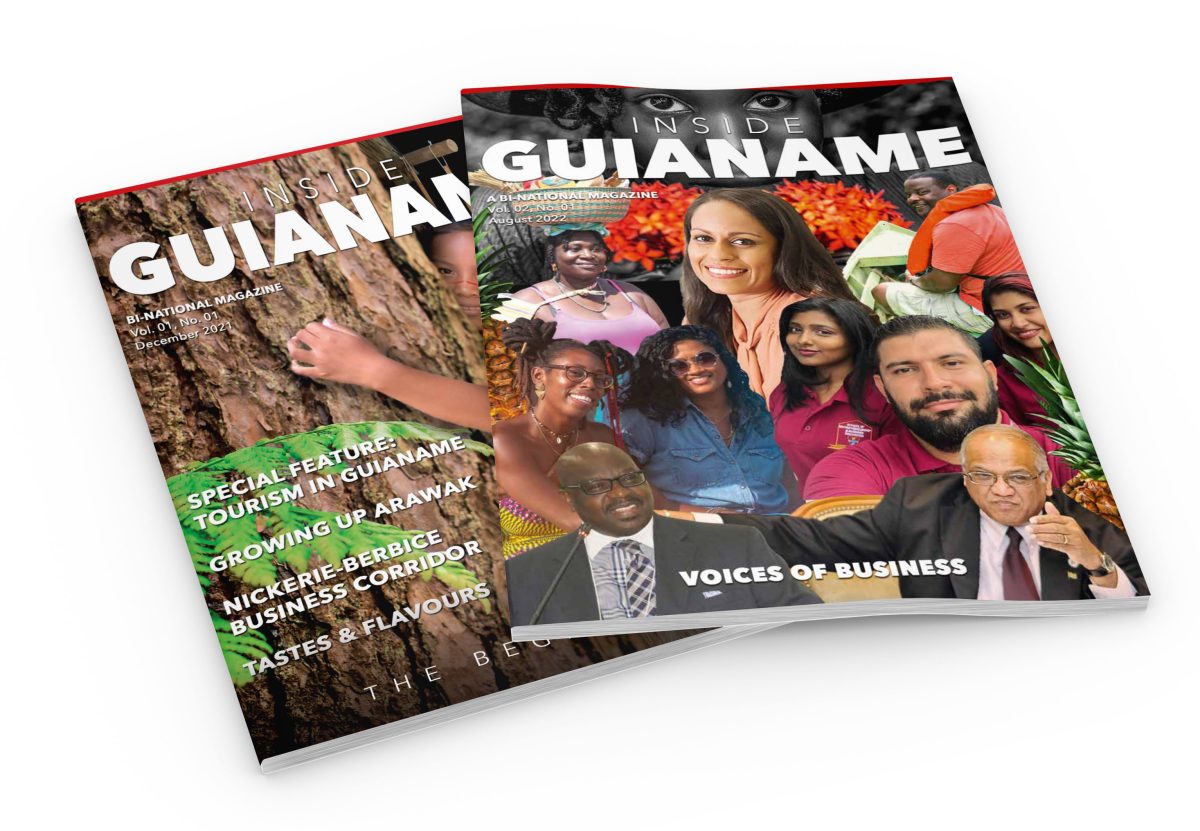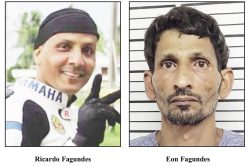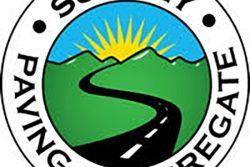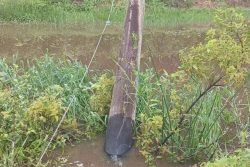LOVE’S GUIDE
One could see the beauty of the body
But could only feel the beauty of the soul
But what does it matter
True love is blind
Feeling is her seeing eyes
Ivan Forrester

You cannot pick up a copy of the magazine Inside Guianame without being impressed that you hold in your hands a cultural treasure – a social and literary, even scientific, superstructural manifestation in art and letters of the ancient mysteries of the landmass called The Guiana Shield, known today as The Guianas.
This magazine is a printed representation of that corner of the earth on the north-eastern shoulder of South America once transmigrated by peoples who recognised no boundaries until the arrival of Europeans with a sense of territory, who introduced division into the three Guianas – British, Dutch and French. The ensuing history of conflicts and immigration had one single beauty – the creation of societies of ethnic and cultural plurality, to go along with geology, landscape, rainforests and waterways to fashion realms of unsurpassed and breathtaking magnificence.
Inside Guianame has the distinction of bringing to readers, visitors, researchers, explorers, travel writers, scientists and anthropologists visual manifestations of the results of that history, that cultural beauty that repose in those three territories – British Guiana, Dutch Guiana and French Guiana. It actually focuses on two of them, now the independent Republics of Guyana and Suriname. The magazine brings out what unites the two neighbouring nations, redoing much of what was undone by the forces of history – the wars, colonisation and immigration, slavery and indentureship. Yet those same forces, which were as much instruments of plunder as they were of creation.
The concept of “Guianame” suggests a combination of the two countries, bringing to the fore much of what they have in common and covering several fields and areas of interests. In a sense it unites two nations divided by the mighty Corentyne River, which carries in its streams and on its banks factors of history, politics, geography, language and culture that are agents of separation, and even conflict. But the same river is a uniting phenomenon, testifying to two peoples brought together by matching factors of social interaction, politics, culture, geography and economic life.
Thus, the magazine is a recognised cultural treasure for the pictures and words within its printed pages and for its own polished, glossy, spectacular appearance. It is very well edited and produced, and possesses depth of content in a wide range of interests and areas that are covered in its articles and photographs.
Inside Guianame: Means Business, Spring 2024 is the Fourth Edition of this magazine edited by Donald Sinclair and Sean F. Taylor and published in both Georgetown and Paramaribo. While its main language is English, it contains features in Sranan, Sarnami, Creole (Ayiti), French and Dutch. These languages are a crucial part of the flavour of the publication and the mandate that it has given itself – to reflect the culture of the two countries. English is a major national language common to both, while Sranan is a creole language nationally recognised in Suriname, where Dutch is an official language and the minor creole Sarnami is also spoken. The Creole Ayiti is common to Haiti and French Guiana, whose official language is French.
The magazine carries articles by sundry writers and main contributors in several disciplines and subjects. It is strong on the arts, and there are poems, selections of prose and scores of colourful photographs that illustrate articles, but include those that are, independently, works of art. The volume also has a major focus and theme, resulting in the sub-title “Guianame Means Business”. According to Co-Editor In Chief Sinclair “this edition lays bare the energy, passion and dedication that drive entrepreneurship in Suriname and Guyana. Different from other publications, or from many mainstream organs, Inside Guianame 4 directs attention to those off-the-beaten track business endeavours and enterprises: the smaller entrepreneur who is making a quiet difference in the life of the community around him or her. While we are eternally grateful for, and will always applaud, the enterprises of the grand players – Fernandes, Yokohama and the like in Suriname; Banks DIH, Demerara Distillers Limited, Gafoor’s, John Fernandes and others in Guyana, our focus is upon the smaller players whose presence in the business landscape is just as vital.”
Appropriately, there is a section of more than 20 pages in which “some of the bold entrepreneurs of Guyana and Suriname” are “saluted”. The collection of stories and interviews, “Saluting Our Entrepreneurs” is introduced by the editor in chief and features a number of owners of small businesses, one of whom, has founded and owns as many as six businesses. Interestingly, Dr Kiven Pierre is an academic, featured in this interview as “The Serial Entrepreneur”. However, this theme of entrepreneurship occupies a significant number of articles with such sub-titles as “Financial Literacy” – with the pun “Money Matters”; Business & Nature; Business and Cuisine; and The Beauty Business. Many articles focus cuisine and foods with another equal number on nature, the environment and eco-tourism and the way all of these inspire different kinds of business concerns.
Sometimes connected to these is the area of tourism and hospitality, both of which are linked to cuisine, nature and the environment. But other contributions help to reveal wonders of the Guianese landscape and natural beauty. Going through the magazine, there is always quite a strong sense of those.
There is also a spotlight turned on education , including entrepreneurship in the field of education. There is attention to the AlphaMax Academy, a school in Paramaribo,. in an article which links it as well, to tourism and hospitality. What helps to lend the publication some depth is this close attention to context and theme with that ever-present sense of a geographical region.
In addition, regardless of any specific theme, volume 4 of the Guyaname periodical pays clear attention to the arts. There is a segment on the visual arts and selections of poetry. The new Haitian Cultural House in Paramaribo is a major feature – “The House of Culture”, fully printed in both English and French, which further illustrates the magazine’s artistic/cultural identity that it demonstrates in its foregrounding of spoken languages. The article speaks to a “culture haitienne” which is “riche et diversifiee” just as the magazine itself is and just as the two countries Suriname and Guyana are. It tells about the opening of “the first Haitian Government House of Culture in Suriname”, established on February 29, 2024 in Paramaribo.
This attention to art starts with a short feature on a Guyanese artist who centres his work on the calabash or krabasi. The cameo is called “Daniel Ramiah: Krabasi Artist Extraordinaire” and gives a snapshot of Ramiah, who was born in Vreed-en-Hoop and how he crafts the calabash.
It continues with “Art Splash” details of “Art Expo 23” an exhibition of Surinamese and Guyanese art exhibited in Suriname at the AlphaMax Exhibition Hall in Suriname. It shows an extraordinary collection of paintings and drawings by many artists, each with a line of introduction. They include the Guyanese painter (auto-didactic artist) Pe-Kah-Iah James, Maharanie Jhillu, founder of Artful Expressions and Secretary of the Guyana Women Artists Association, Cosmata Lindie and Roberto Teekah , also of Guyana, as well as Surinamese Lyroy Caupin, Raymill Nerkust, Sophia Naarden, Saskia Pinas, Renoucka Dipotiko and Cliff Rasidin.
Samples of the work considerably adorn the pages of the magazine and there are also several pictures taken from the exhibition. Elegant photo ops, but there is nothing printed to give any information about this show for which Guyanese artists traveled to Suriname. It would have helped readers, particularly those interested in art, and researchers, if the occasion was placed in at least archival context.
The arts continue with a piece on Sonny Khoeblal, “A Musical Maestro From Suriname” and an insight into poetry from both countries. Inside Guianame’s “Featured Poet” is Ivan Forrester, known as “Farro” (or “Farao” as the magazine has it), also a visual artist and hydro-meteorological technician, and a famed friend of Martin Carter. There is a narrative from Forrester’s daughter, Jackie Forrester. A priceless document is the printing of four of his poems – three love poems and patriotic verse. Of interest – Forrester’s mother was Surinamese.
Of interest, as well, is “Jit Narain: Poet in the Grip of Sarnami”, which presents a Surinamese poet of Hindustani ancestry who is deeply concerned with the history and aftermath of Indian immigration into Suriname under indentureship. He is a medical doctor who has been writing and publishing in the Sarnami language.
The finishing polish is the poetry of Ivan A. Khayiat, who we might jokingly call the poet in residence of Inside Guianame. His poem “Hold Steadfast”, also titled “Hori Ati” is printed in addition to three others, one of which is a reference to the tragic fire at a boarding school in Mahdia, Guyana. True to the linguistic preoccupations of the magazine, Khaviat’s poetry is translated into Sranan by d. france olivieira.
Inside Guianame 4 appeals to a general audience and will have features of value to a number of special interests as well. So far it seems to have proven itself to both readers and advertisers, to cultural and business interests in both Guianas – the English and the Dutch.





